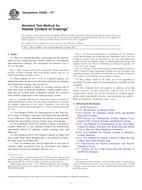Potřebujeme váš souhlas k využití jednotlivých dat, aby se vám mimo jiné mohly ukazovat informace týkající se vašich zájmů. Souhlas udělíte kliknutím na tlačítko „OK“.
ASTM D2369-10e1
Standard Test Method for Volatile Content of Coatings (Includes all amendments And changes 7/1/2015).
Automaticky přeložený název:
Standardní zkušební metoda pro obsah těkavých látek Coatings
NORMA vydána dne 1.7.2011
Informace o normě:
Označení normy: ASTM D2369-10e1
Poznámka: NEPLATNÁ
Datum vydání normy: 1.7.2011
Kód zboží: NS-20163
Počet stran: 5
Přibližná hmotnost: 15 g (0.03 liber)
Země: Americká technická norma
Kategorie: Technické normy ASTM
Anotace textu normy ASTM D2369-10e1 :
Keywords:
multicomponent paints, nonvolatile determination, VOC baking temperature, VOC in paints, volatile determination, volatiles, Latex paints, Multicomponent paints, Nonvolatile matter content--paints/related coatings/materials, Paint testing, Solventborne paints/coatings, VOC calculation, Volatile matter content--paints/related coatings/materials, Volatile organic compounds (VOC)--paints/related coatings, ICS Number Code 87.040 (Paints and varnishes)
Doplňující informace
| Significance and Use | ||||||||||||||||||||
|
This test method is the procedure of choice for determining volatiles in coatings for the purpose of calculating the volatile organic content in coatings under specified test conditions. The weight percent solids content (nonvolatile matter) may be determined by difference. This information is useful to the paint producer and user and to environmental interests for determining the volatiles emitted by coatings. |
||||||||||||||||||||
| 1. Scope | ||||||||||||||||||||
|
1.1 This test method describes a procedure for the determination of the weight percent volatile content of solventborne and waterborne coatings. Test specimens are heated at 110 ± 5°C for 60 min. Note 1—The coatings used in these round-robin studies represented air-dried, air-dried oxidizing, heat-cured baking systems, and also included multicomponent paint systems. 1.2 Sixty minutes at 110 ± 5°C is a general purpose test method based on the precision obtained with both solventborne and waterborne coatings (see Section 9). 1.3 This test method is viable for coatings wherein one or more parts may, at ambient conditions, contain liquid coreactants that are volatile until a chemical reaction has occurred with another component of the multi-package system. Note 2—Committee D01 has run round-robin studies on volatiles of multicomponent paint systems. The only change in procedure is to premix the weighed components in the correct proportions and allow the specimens to stand at room temperature for 1 h prior to placing them into the oven. 1.4 Test Method D5095 for Determination of the Nonvolatile Content in Silanes, Siloxanes and Silane-Siloxane Blends Used in Masonry Water Repellent Treatments is the standard method for nonvolatile content of these types of materials. 1.5 Test Methods D5403 for Volatile Content of Radiation Curable Materials is the standard method for determining nonvolatile content of radiation curable coatings, inks and adhesives. 1.6 Test Method D6419 for Volatile Content of Sheet-Fed and Coldset Web Offset Printing Inks is the method of choice for these types of printing inks. 1.7 This test method may not be applicable to all types of coatings. Other procedures may be substituted with mutual agreement between the producer and the user. Note 3—If unusual decomposition or degradation of the specimen occurs during heating, the actual time and temperature used to cure the coating in practice may be substituted for the time and temperature specified in this test method, subject to mutual agreement between the producer and the user. The U.S. EPA Reference Method 24 specifies 110 ± 5°C for 1 h for coatings. Note 4—Practice D3960 for Determining Volatile Organic Compound (VOC) Content of Paints and Related Coatings describes procedures and calculations and provides guidance on selecting test methods to determine VOC content of solventborne and waterborne coatings. 1.8 The values stated in SI units are to be regarded as standard. No other units of measurement are included in this standard. 1.9 This standard does not purport to address all of the safety concerns, if any, associated with its use. It is the responsibility of the user of this standard to establish appropriate safety and health practices and determine the applicability of regulatory limitations prior to use. |
||||||||||||||||||||
| 2. Referenced Documents | ||||||||||||||||||||
|




 Cookies
Cookies
